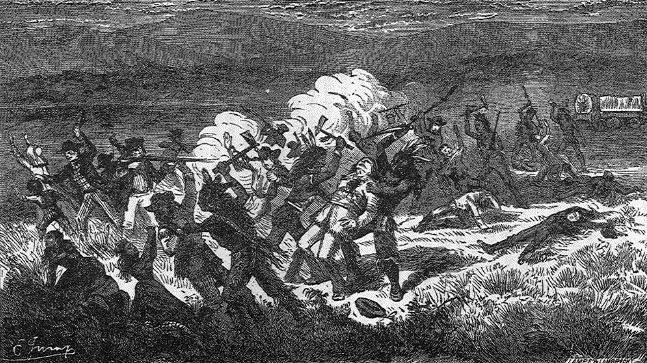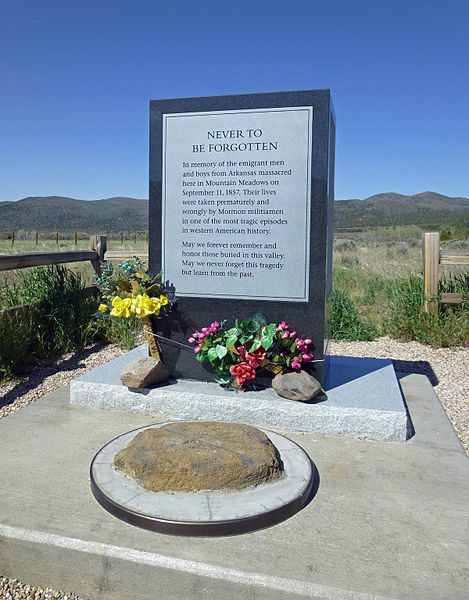
(Wikimedia Commons public domain image)
Having just read two new books on the subject — Vengeance Is Mine: The Mountain Meadows Massacre and Its Aftermath, by Richard E. Turley Jr. and Barbara Jones Brown, and Convicting the Mormons: The Mountain Meadows Massacre in American Culture, by Janiece Johnson — I published an article in Meridian Magazine today, Friday, that appears under the title of “Searching Out the Truth about the Mountain Meadows Massacre.” You are welcome to read it. There is no charge and it’s unlikely that you’ll be damaged by the experience in any really permanent way.

(Wikimedia Commons public domain image)
Moreover, four new articles went up today on the website of the Interpreter Foundation:
“Moses as Midwife: What the Exodus Birth Story Teaches about Motherhood and Christ,” written by Becky Holderness Tilton
Abstract: This work explores an alternative interpretation of the Exodus narrative as a metaphor for childbirth. Gleaning from Old Testament and Judaic sources, we find rich female birth and salvific imagery in the saga of the migration of the children of Israel and the Passover itself. This perspective of sacred childbirth, when coupled with traditional Christian interpretations of the first Passover, ultimately paints an enhanced picture of the Atonement of Jesus Christ.
“Interpreting Interpreter: Birthing Israel,” written by Kyler Rasmussen
This post is a summary of the article “Moses as Midwife: What the Exodus Birth Story Teaches about Motherhood and Christ” by Becky Holderness Tilton in Volume 57 of Interpreter: A Journal of Latter-day Saint Faith and Scholarship. An introduction to the Interpreting Interpreter series is available at https://interpreterfoundation.org/interpreting-interpreter-on-abstracting-thought/.
The Takeaway: Tilton explores the Exodus narrative as a metaphor for the birth of Israel and that metaphor’s implications for our view of spiritual rebirth through Christ.
“Verbal Punctuation in the Book of Mormon II — nevertheless,” written by John Gee
Abstract: One example of verbal punctuation that has a very clear pattern of usage in the Book of Mormon is the term nevertheless. It is used to draw a marked contrast between what the previous text would lead one to expect and what follows it. It is not clear what the ancient antecedent to the term might be and the English term and usage might be an artefact of the translation process. The frequency and usage of nevertheless in the Book of Mormon contrasts with the way that Joseph Smith’s writings use it.
“Interpreting Interpreter: Nevertheless,” written by Kyler Rasmussen
This post is a summary of the article “Verbal Punctuation in the Book of Mormon II — Nevertheless” by John Gee in Volume 57 of Interpreter: A Journal of Latter-day Saint Faith and Scholarship. An introduction to the Interpreting Interpreter series is available at https://interpreterfoundation.org/interpreting-interpreter-on-abstracting-thought/.
The Takeaway: Gee notes that the word nevertheless is used consistently in the Book of Mormon to mark a contrast between two phrases. That usage does not match Joseph Smith’s use of the term in either type or frequency.

(Wikimedia Commons public domain image)
This is really, really welcome and encouraging news: “The number of Latter-day Saint missionaries is rising rapidly: Scholar says religiosity in recent generations of Latter-day Saints is up compared to baby boomers” May the trend continue! We’ve gone through a relatively bleak period, but things may be looking up again.
My wife and I saw Sound of Freedom on Tuesday, the Fourth of July. There isn’t a trace of QAnonism in it, so far as I could tell. (I have no sympathy whatever for QAnon. Quite the contrary, in fact.) My only complaint, to be perfectly candid, is about the film’s pacing. I thought it somewhat slow, especially in its first half, and overly long. It could have been edited down a bit. That said, I hope that as many people as possible will go to see it. Efforts like this need to be supported, and the cause to which the film seeks to call attention is enormously important: “God’s Children Are Not for Sale.”
And, by the way, Tim Ballard — who is portrayed in the film by Jim Caviezel (who starred in such films as The Passion of the Christ and in The Count of Monte Cristo) — is a Latter-day Saint, and, although the film doesn’t mention his religious affiliation (it actually shows him drinking coffee and tee and, on one occasion, smoking a cigarette to create rapport with a captured pedophile) and wasn’t produced by members of the Church, Angel Studios, which is distributing Sound of Freedom, is based in Provo, Utah.

(Wikimedia Commons public domain image)
Finally, here are a few short but gratifyingly horrific articles retrieved, for your indignation, from the Christopher Hitchens Memorial “How Religion Poisons Everything” File™:
- “Living on a prayer? How attending worship can improve your physical and mental health.: People who attend worship services regularly tend to have more close friendships, which can in turn lead to better health outcomes.”
- “Opinion: Changing the narrative on religion and the LGBTQ community: Church members of all stripes should feel comfortable engaging in conversations about faith with their LGBTQ brothers and sisters”
- “Donation Modernizes Emergency Shelter Services in Montreal”
- “Decline in Religion Doesn’t Bode Well for the Republic”
- “Kentucky Governor Thanks the Church of Jesus Christ for Flood Relief: Some 3,000 Latter-day Saints gave 65,872 hours of service to clean out 867 damaged homes in August 2022”
Posted from Ucluelet, British Columbia













